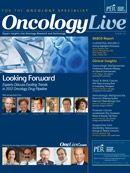Publication
Article
Oncology Live®
Addition of Bevacizumab May Help in Nasopharyngeal Cancer
Author(s):
Researchers are reporting favorable early results with the addition of bevacizumab to conventional chemoradiation in patients with advanced nasopharyngeal cancer.
Nancy Y. Lee, MD
Researchers are reporting favorable early results with the addition of bevacizumab to conventional chemoradiation in patients with advanced nasopharyngeal cancer.
The Radiation Therapy Oncology Group phase II RTOG 0615 trial, which enrolled 46 patients with previously untreated locoregionally advanced nasopharyngeal cancer, found that the experimental regimen “is feasible, and may improve distant metastasis-free interval.”
Nancy Y. Lee, MD, a radiation oncologist at Memorial Sloan-Kettering Cancer Center in New York City, and associates treated patients with 3 cycles of bevacizumab (15 mg/kg) and cisplatin (100 mg/m2) both given on days 1, 22, and 43 of radiation (70 Gy) with intensity-modulated radiation therapy delivered over 33 days, every day Monday through Friday.
Afterward, they received 3 cycles of bevacizumab (15 mg/kg) and cisplatin (80 mg/ m2), both given on days 64, 85, and 106 after radiotherapy, and 3 cycles of fluorouracil (1000 mg/m2 per day), given on days 64-67, 85-88, and 106-109 after radiotherapy.
Lee et al pointed out that despite local tumor control rates that exceed 90% with chemotherapy plus intensitymodulated radiotherapy, distant metastasis occurs in nearly a third of patients within 5 years and eventually leads to death.
Bevacizumab was selected for evaluation because it has been shown to improve the response rate and overall survival in metastatic colorectal and non-small cell lung cancer in phase III studies when used in tandem with standard chemoradiotherapy. The humanized monoclonal antibody, which inhibits vascular endothelial growth factor, also yielded favorable results when combined with chemoradiation for preoperative rectal cancer.
The present study found that while hemorrhage is a wellknown complication of bevacizumab, there were no instances of grade 3 or 4 hemorrhage in 44 evaluable patients.
Nine patients had grade 1 hemorrhage, and 1 patient had grade 2 hemorrhage—all of which were possibly due to treatment. Only 1 patient died without evidence of disease progression, thereby suggesting that bevacizumab was not responsible for any unexpected toxic deaths, the authors said.
With a median follow-up of 2.5 years, the 2-year distant metastasis-free interval was 90.8% (82.2—99.5), the 2-year progression-free survival was 74.7% (61.8– 87.6), and 2-year overall survival was 90.9% (82.3–99.4).
The study found major deviations in target volume in nearly a third of patients, which “were associated mostly with delineations of level V neck nodes or the skull base encompassed in the elective irradiation target volumes.”
The investigators emphasized that while the overall results are encouraging, “toxicity was still substantial and compliance to protocol treatment was still not ideal.”
Concomitant chemoradiation remains the treatment standard for nasopharyngeal carcinoma, and further research is needed to identify which patients are at risk of distant metastasis, and thus might benefit most from the addition of bevacizumab, they said.
Lee NY, Zhang Q, Pfister DG, et al. Addition of bevacizumab to standard chemoradiation for locoregionally advanced nasopharyngeal carcinoma (RTOG 0615): a phase 2 multi-institutional trial [published online December 15, 2011]. Lancet Oncol. doi: 10.1016/S1470-2045(11)70303-5.










